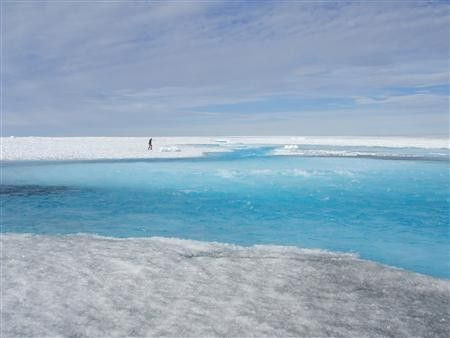Climate change melts Greenland’s ice sheet rapidly, accelerating sea level rise

Researchers say that the Greenland ice sheet is quickly losing the ability to hinder sea level rise despite being known as a sponge for glacier meltwater. The study, published in the journal Nature, projects that sea level rise due to meltwater runoff is likely higher than what was previously predicted.
"We were interested in the thin porous near-surface firn layer and how its physical structure is changing rapidly with climate change," study co-author William Colgan said in a press release. "The study looked at very recent climate change on the ice sheet, how the last couple of years of melt have really altered the structure of the ice sheet firn and made it behave differently to future melt."
Colgan, who is a professor at at the Lassonde School of Engineering, spent five weeks drilling firn cores in Greenland ice sheet’s interior back in 2013. According to the scientists, firn is snow that has been compacted for many years, but is not yet as dense as glacier ice. Instead, firn forms a porous layer near the surface of the ice sheet.
The team drilled a series of shallow firn cores, 20 metres deep, during the expedition. The scientists also towed a radar unit to gather profiles between the core sites along a path, measuring 100 kilometres, from the lower ice sheet elevation margin into the higher elevation ice sheet interior. They cut the firn cores into small sections to measure the cores’ properties including the density and compare these to samples collected in 2014, with Colgan describing the year-on-year firn changes as dramatic.
They said that an extreme melt back in 2012 caused a solid layer of ice, several metres thick, forming on top of the porous firn in the lower elevation portion of the ice sheet. Lead researcher Horst Machguth said that this shows that firn reacts quickly to changing climate. The firn’s ability to limit mass loss of the ice sheet by retaining meltwater could be smaller than previously thought.
"In subsequent years, meltwater couldn't penetrate vertically through the solid ice layer, and instead drained along the ice sheet surface toward the ocean,” Colgan added. "It overturned the idea that firn can behave as a nearly bottomless sponge to absorb meltwater. Instead, we found that the meltwater storage capacity of the firn could be capped off relatively quickly."
Currently, projecting Greenland’s sea level rise does not normally include an estimation of firn cap. However, with the new findings, the physical processes observed will now be an important part of measuring the levels accurately. Colgan also plans to survey ice sheet changes caused by the development of massive ice layers associated with the firns.





















